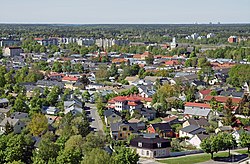
Back Rauma Afrikaans راوما Arabic راوما ARZ Раўма Byelorussian Rauma (Finlàndia) Catalan Rauma (munisipyo) CEB Rauma Czech Rauma (Finland) Danish Rauma German Raŭmo Esperanto
Rauma
Raumo | |
|---|---|
Town | |
| Rauman kaupunki Raumo stad | |
 Rauma in May 2012 | |
| Motto: Kyl Raum o ain Raum | |
 Location of Rauma in Finland | |
| Coordinates: 61°08′N 021°30′E / 61.133°N 21.500°E | |
| Country | |
| Region | Satakunta |
| Sub-region | Rauma |
| Charter | 1442-04-17 |
| Government | |
| • Town manager | Kari Koski |
| Area (2018-01-01)[1] | |
• Total | 1,110.12 km2 (428.62 sq mi) |
| • Land | 496.43 km2 (191.67 sq mi) |
| • Water | 614.48 km2 (237.25 sq mi) |
| • Rank | 176th largest in Finland |
| Population (2024-10-31)[2] | |
• Total | 38,957 |
| • Rank | 29th largest in Finland |
| • Density | 78.47/km2 (203.2/sq mi) |
| • Demonym | Raumalainen (Finnish) Raumlaine (Dialect) |
| Population by native language | |
| • Finnish | 91.1% (official) |
| • Swedish | 0.3% |
| • Others | 8.6% |
| Population by age | |
| • 0 to 14 | 14.5% |
| • 15 to 64 | 59.3% |
| • 65 or older | 26.2% |
| Time zone | UTC+02:00 (EET) |
| • Summer (DST) | UTC+03:00 (EEST) |
| Climate | Dfb |
| Website | www |
| Official name | Old Rauma |
| Type | Cultural |
| Criteria | iv, v |
| Designated | 1991 |
| Reference no. | 582 |
Rauma (Finnish: [ˈrɑu̯mɑ]; Swedish: Raumo) is a town in Finland, on the western coast of the country. Rauma is in the Satakunta region, by the Gulf of Bothnia. The population of Rauma is approximately 39,000, while the sub-region has a population of approximately 65,000. It is the 29th most populous municipality in Finland.
Rauma lies 92 kilometres (57 mi) north of Turku and 50 kilometres (31 mi) south of Pori. Its neighbouring municipalities are Eura, Eurajoki, Laitila and Pyhäranta. Granted town privileges on 17 April 1442 (then under the rule of Sweden), Rauma is known for its paper and maritime industry, high quality lace (since the 18th century) and the old wooden architecture of the city centre (Old Rauma, Vanha Rauma), which is a UNESCO World Heritage Site.[6]
- ^ "Area of Finnish Municipalities 1.1.2018" (PDF). National Land Survey of Finland. Retrieved 30 January 2018.
- ^ "Finland's preliminary population figure was 5,635,560 at the end of October 2024". Population structure. Statistics Finland. 2024-11-19. ISSN 1797-5395. Retrieved 2024-11-22.
- ^ "Population growth biggest in nearly 70 years". Population structure. Statistics Finland. 2024-04-26. ISSN 1797-5395. Retrieved 2024-04-29.
- ^ "Population according to age (1-year) and sex by area and the regional division of each statistical reference year, 2003–2020". StatFin. Statistics Finland. Retrieved 2 May 2021.
- ^ a b "Luettelo kuntien ja seurakuntien tuloveroprosenteista vuonna 2023". Tax Administration of Finland. 14 November 2022. Retrieved 7 May 2023.
- ^ "Old Rauma". UNESCO World Heritage Centre. United Nations Educational, Scientific, and Cultural Organization. Retrieved 25 September 2021.
